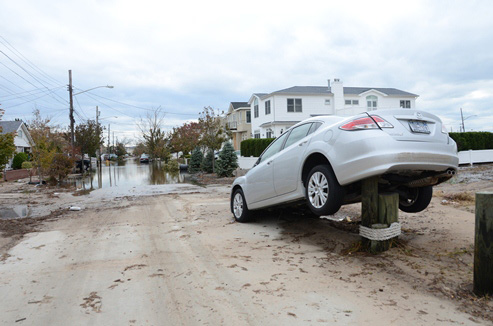6 car insurance lessons from Superstorm Sandy
Tamara E. Holmes
While the media coverage of Superstorm Sandy showed floodwaters ravaging homes along the New Jersey and New York coasts, the disaster also was responsible for an estimated 230,000 car insurance claims. While some of them may have been for minor damage such as paint scratches or dents from flying debris, others undoubtedly were for vehicles that spent days underwater.
A flood can cause massive damage to a vehicle and a major headache for the vehicle’s owner. Here are six things you need to know about auto insurance before, during and after a flood.
1. Make sure you’re covered.
Just as you need flood insurance to cover your house from damaging floodwaters, you need comprehensive insurance to protect your car from a flood, says Jeanne Salvatore, a spokeswoman for the nonprofit Insurance Information Institute. Comprehensive insurance, which covers non-collision damage to your car, is optional; many people drop it when their cars are worth less than the cost of insurance. But if you don’t have comprehensive insurance and your car gets flooded, whether from a hurricane or a water main break, you’ll be on the hook for all of the damage to your car.
2. Consider gap insurance.
 Since cars depreciate the minute you drive them off the car lot, if you financed a new car in the past year or two, there’s a good chance you owe more on the car than it’s worth. If a flood damages your car beyond repair, your car insurance company will pay you what the car’s worth, but you’ll have to come up with the rest of the funds to finish paying off the loan, according to Russell Longcore, author of “Insurance Claim Secrets Revealed.” Gap insurance will cover the difference between the cash value of a car, which is the amount the insurance company will pay, and the amount you owe. If you live in a flood-prone area, it’s worth considering.
Since cars depreciate the minute you drive them off the car lot, if you financed a new car in the past year or two, there’s a good chance you owe more on the car than it’s worth. If a flood damages your car beyond repair, your car insurance company will pay you what the car’s worth, but you’ll have to come up with the rest of the funds to finish paying off the loan, according to Russell Longcore, author of “Insurance Claim Secrets Revealed.” Gap insurance will cover the difference between the cash value of a car, which is the amount the insurance company will pay, and the amount you owe. If you live in a flood-prone area, it’s worth considering.
3. Avoid flooded roads.
While you can’t control whether your neighborhood is hit by a natural disaster, you can take safety precautions to decrease your risk of your car getting damaged in the first place. If you have to be out in a heavy rainstorm, reduce your speed and avoid flooded roads, particularly if water is moving swiftly, AAA says. But it’s not just high water you need to look out for – vehicles can be swept away by just 2 feet of rushing water.
4. Assess your damage.
If your car is ever submerged in flood waters, several major parts are vulnerable, including the engine, the transmission, and the fuel, braking and power steering systems. Before you start the car, AAA advises you to have the car towed to a qualified technician who can inspect the mechanical and electrical parts and drain floodwater. A technician may have to dissemble car parts to remove the dirt and other contaminants.
5. Get your insurer involved.
Since draining floodwater from a car can cost more than the vehicle is worth, particularly if it’s an old car, AAA recommends contacting your insurer before having any work done. Dealing with flood damage is no different than filing any other type of car insurance claim, Salvatore says. The insurer will assign a claims adjuster to assess your damage and determine how much you should be compensated. Use your smartphone to take pictures of the damage, which can aid your insurer during the claims process. .
6. Be wary of flood-damaged cars.
You can be affected by flood damage long after a flood has passed if you’re in the market for a used car. Cars that were severely flood damaged may be on sale, with no indication of their history. You even can be affected if you live far away from a flooded region.
In the case of Superstorm Sandy, “you might find one of these water-logged lemons for sale even if you are in Washington state,” says Frank Scafidi, a spokesman for the nonprofit National Insurance Crime Bureau. The biggest clues that a vehicle may have been damaged in a flood are that it has a low price compared with similar models, and that its title reveals the vehicle has had previous owners in several states, Scafidi says.
To avoid buying a flood damaged car, use NCIB’s VINCheck service. VINCheck allows you to run the car’s VIN (vehicle identification number) through a database to see whether the vehicle ever has been declared a total loss – or deemed damaged beyond repair – by an insurance company.
